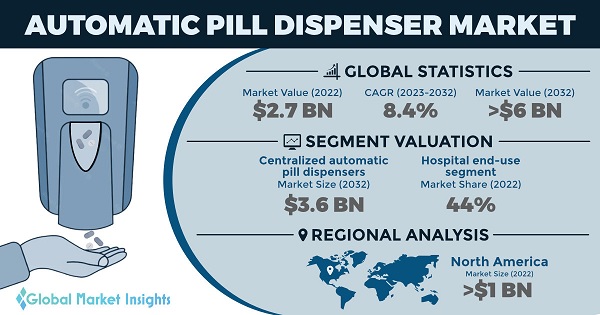Automatic Pill Dispenser Market Size
Automatic Pill Dispenser Market size was worth USD 2.7 billion in 2022 and is poised to exhibit 8.4% CAGR from 2023 to 2032 driven by the growing burden of diseases worldwide.

The surging prevalence of chronic conditions, including diabetes, cardiovascular diseases, and respiratory ailments has necessitated the use of multiple drugs on daily basis. Automatic pill dispensers provide systematic and effective methods for handling complex drug regimens, ensuring that patients follow their treatment programs. To that end, the rising illness burden, particularly the higher frequency of chronic disorders and the issues associated with drug administration.
Automatic Pill Dispenser Market Report Attributes
| Report Attribute |
Details |
| Base Year | 2022 |
|---|
| Automatic Pill Dispenser Market Size in 2022 | USD 2.7 Billion |
|---|
| Forecast Period | 2023 to 2032 |
|---|
| Forecast Period 2023 to 2032 CAGR | 8.4% |
|---|
| 2032 Value Projection | USD 6.1 Billion |
|---|
| Historical Data for | 2018 to 2022 |
|---|
| No. of Pages | 180 |
|---|
| Tables, Charts & Figures | 342 |
| Segments covered | Product, End-use and Region |
|---|
| Growth Drivers | - Advantages offered by automatic pill dispensers
- Rise in geriatric population
- Recent technological advancements
- Growing burden of diseases
|
|---|
| Pitfalls & Challenges | - High cost of the device
- Error caused by the machine
|
|---|
The rising prices of automatic pill dispensers may impede the industry expansion to some extent. While automatic pill dispensers offer convenience and improved medication management, their prices can be unaffordable for some customers. Individuals with low financial means, such as elderly people on fixed incomes and those without limited insurance coverage, are disproportionately affected by affordability issues.
COVID-19 Impact
The COVID-19 pandemic had negative influence on the automatic pill dispenser industry in 2020 considering the hampered global supply chains that affected the manufacturing and delivery of different goods, including automatic pill dispensers. Supply chain disruptions caused shortages and delays in the availability of the dispensers, decreasing the user access. Since resources and focus were diverted to pandemic-related issues, the introduction and integration of automated pill dispensers within healthcare systems was suspended.
Automatic Pill Dispenser Market Trends
Technical improvements, such as upgraded connection features, integration with smart devices and home automation systems, as well as the application of AI algorithms to improve medication administration and adherence will also drive the industry. There has also been a significant rise in the integration of automated pill dispensers with remote monitoring capabilities and telemedicine platforms. The increasing prominence of data gathering and analysis for medication adherence will augment the business outlook.
Automatic Pill Dispenser Market Analysis
Based on product, the centralized automatic pill dispenser market is set to gain substantial traction, reaching USD 3.6 billion by 2032. Centralized inventory tracking systems provide improved control of pharmaceutical stock levels whilst preventing medicine shortages, reducing waste, and improving efficiency in the drug supply chain. These dispensers also offer advanced features, such as remote monitoring, real-time medication tracking, and connectivity with healthcare providers.
With respect to end-use, the hospital segment held 44% revenue share of the automatic pill dispenser market in 2022. The progression can be attributed to the growing medication management issues, drug safety, accuracy concerns, electronic health record integration, and centralized medication management. Hospitals are rapidly implementing automatic pill dispensers to improve medication administration to increase patient safety and optimize workflow efficiency.
North America held dominant share of the automatic pill dispenser market, accounting for over USD 1 billion in 2022 due to the expanding aging population and favorable reimbursement policies. The growing technological advancements have made way for well-established healthcare infrastructure in the region. Moreover, the rising awareness of the benefits of automatic pill dispensers in enhancing patient safety and reducing medication errors coupled with the robust presence of key industry players.
Automatic Pill Dispenser Market Share
Some of the leading companies operating in the automatic pill dispenser market include
- Becton
- Dickinson and Company
- Capsa Healthcare
- ARxIUM Inc
- Accu-Chart Plus Healthcare Systems Inc
- Cerner Corporation
- Hero Health Inc
- ScriptPro LLC
- Medipense Inc
- InstyMeds Corporation
- Medminder Systems Inc
- Omnicell Inc
- Pharmacell Medications Systems Ltd
- Swisslog Healthcare AG
- McKesson Corporation
Automatic Pill Dispenser Industry News
- In July 2022, Becton Dickinson and Company acquired Parata Systems, a firm that offers cutting-edge pharmacy automation solutions, to provide improved patient safety while enhancing patient experience for hospital, retail, and long-term care pharmacies.
Automatic pill dispenser market research report includes in-depth coverage of the industry with estimates & forecast in terms of revenue in USD (million) from 2018 to 2032 for the following segments
Click here to Buy Section of this Report
By Product, 2018 - 2032 (USD Million)
- Centralized Automatic Dispenser
- Decentralized Automatic Dispenser
- Ward Based Automated Dispensing System
- Pharmacy Based Automated Dispensing System
- Automatic Unit Dose Dispensing System
By End-use, 2018 - 2032 (USD Million)
- Hospitals
- Pharmacies
- Senior Care
- Others
The above information is provided for the following regions and countries
- North America
- Europe
- Germany
- UK
- France
- Spain
- Italy
- Poland
- Switzerland
- The Netherlands
- Asia Pacific
- Japan
- China
- India
- Australia
- South Korea
- Indonesia
- Thailand
- Philippines
- Latin America
- Brazil
- Mexico
- Argentina
- Chile
- Colombia
- Peru
- Middle East & Africa
- South Africa
- Saudi Arabia
- UAE
- Israel
- Iran
- Turkey




